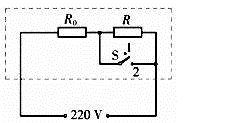某种电热水壶有加热和保温两种工作状态,从它的说明书上收集到如下数据及如图15所示的简化电路原理图。(保温功率为饮水机处于保温状态时的饮水机的总功率)
求解下列问题:
(1)当开关S与接线柱1相连时,①饮水机处于__________(填“加热”或“保温”)状态;②电路中的电流。
(2)电阻R的阻值。
(3)电热水壶加满水后,在额定电压下将水从20℃加热到80℃,需要加热多长时间?(假设电流产生的热量全部被水吸收)[1L=1×10-3m3,c水=4.2×103J/(kg·℃)]
| 容量 | L |
| 额定电压 | 220V |
| 加热功率 | 1000W |
| 保温功率 | 44W |

(1)①保温② 0.2A(2)1051.6Ω(3)252s
题目分析:(1)根据公式 可知,电源电压不变,当电路电阻最大时,电路消耗的电功率最小,处于保温状态;当电路电阻最小时,电路消耗的电功率最大,处于加热状态;①当开关S与接线柱1相连时,电路中两电阻串联,电阻相对较大,电功率较小,处于保温状态;②表中保温功率P保=44W,保温状态下的电流为:
可知,电源电压不变,当电路电阻最大时,电路消耗的电功率最小,处于保温状态;当电路电阻最小时,电路消耗的电功率最大,处于加热状态;①当开关S与接线柱1相连时,电路中两电阻串联,电阻相对较大,电功率较小,处于保温状态;②表中保温功率P保=44W,保温状态下的电流为: ;
;
(2)保温状态下的电路的总电阻: ,
,
当开关S与接线柱2相连时,电阻R被短路,此时电路电阻最小,电功率最大,处于加热状态,加热状态下的R0电阻值: ,所以电阻R的阻值:R=R总-R0=1100Ω-48.4Ω=1051.6Ω;
,所以电阻R的阻值:R=R总-R0=1100Ω-48.4Ω=1051.6Ω;
(3)水的质量m=ρV=1×103kg/m3×1×10-3m3=1kg,
水吸收的热量:Q吸=cm(t-t0)=4.2×103J/(kg•℃)×1kg×(80℃-20℃)=2.52×105J,
因为电流产生的热量全部被水吸收,所以电热水壶在额定电压下放出的热量:Q放=Q吸=2.52×105J,
因为Q=W=Pt,所以加热的时间:
答:(1)①保温;②电路中的电流为0.2A;(2)电阻R的阻值1051.6Ω;(3)需要加热的时间为252s.
